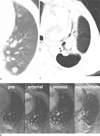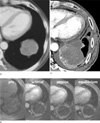1. Fry WA, Phillips JL, Menck HR. Ten-year survey of lung cancer treatment and survival in hospitals in the United States: a national cancer data base report. Cancer. 1999. 86:1867–1876.
2. Hsu CP, Hsu NY, Chen CY. Surgical experience in treating T4 lung cancer: its resectability, morbidity, mortality and prognosis. Eur J Surg Oncol. 1996. 22:171–176.
3. Lee JM, Jin GY, Goldberg SN, et al. Percutaneous radiofrequency ablation for inoperable non-small cell lung cancer and metastases: preliminary report. Radiology. 2004. 230:125–134.
4. Suh RD, Wallace AB, Sheehan RE, Heinze SB, Goldin JG. Unresectable pulmonary malignancies: CT-guided percutaneous radiofrequency ablation--preliminary results. Radiology. 2003. 229:821–829.
5. Ketchedjian A, Daly B, Luketich J, Fernando HC. Minimally invasive techniques for managing pulmonary metastases: video-assisted thoracic surgery and radiofrequency ablation. Thorac Surg Clin. 2006. 16:157–165.
6. Dupuy DE, Zagoria RJ, Akerley W, Mayo-Smith WW, Kavanagh PV, Safran H. Percutaneous radiofrequency ablation of malignancies in the lung. AJR Am J Roentgenol. 2000. 174:57–59.
7. Steinke K, Glenn D, King J, et al. Percutaneous imaging-guided radiofrequency ablation in patients with colorectal pulmonary metastases: 1-year follow-up. Ann Surg Oncol. 2004. 11:207–212.
8. Bojarski JD, Duppy DE, Mayo-Smith WW. CT imaging findings of pulmonary neoplasmas after treatment with radiofrequency ablation: results in 32 tumors. AJR Am J Roentgenol. 2005. 185:466–471.
9. Jin GY, Lee JM, Lee YC, Han YM, Lim YS. Primary and secondary lung malignancies treated with percutaneous radiofrequency ablation: evaluation with follow-up helical CT. AJR Am J Roentgenol. 2004. 183:1013–1020.
10. Okuma T, Matsuoka T, Yamamoto A, et al. Assessment of early treatment response after CT-guided radiofrequency ablation of unresectable lung tumours by diffusion-weighted MRI: a pilot study. Br J Radiol. 2009. 82:989–994.
11. Oyama Y, Nakamura K, Matsuoka T, et al. Radiofrequency ablated lesion in the normal porcine lung: long-term follow-up with MRI and pathology. Cardiovasc Intervent Radiol. 2005. 28:346–353.
12. Rofsky NM, Lee VS, Laub G, et al. Abdominal MR imaging with a volumetric interpolated breath-hold examination. Radiology. 1999. 212:876–884.
13. Karabulut N, Martin DR, Yang M, Tallaksen RJ. MR imaging of the chest using a contrast-enhanced breath-hold modified three-dimensional gradient-echo technique: comparison with two-dimensional gradient-echo technique and multidetector CT. AJR Am J Roentgenol. 2002. 179:1225–1233.
14. Goldberg SN, Grassi CJ, Cardella JF, et al. Image-guided tumor ablation: standardization of terminology and reporting criteria. Radiology. 2005. 235:728–739.
15. Vogl TJ, Straub R, Lehnert T, et al. Percutaneous thermoablation of pulmonary metastases. Experience with the application of laser-induced thermotherapy(LITT) and radiofrequency ablation(RFA), and a literature review. Rofo. 2004. 176:1658–1666.
16. Liao WJ, Luo RC, Kang SJ, et al. Investigation of short-term therapy results for radiofrequency ablation by positron emission tomography. Di Yi Jun Yi Da Xue Xue Bao. 2002. 22:376–377.
17. Miao Y, Ni Y, Bosmans H, et al. Radiofrequency ablation for eradication of pulmonary tumor in rabbits. J Surg Res. 2001. 99:265–271.
18. Lencioni R, Crocetti L, Cioni R, et al. Radiofrequency ablation of lung malignancies: where do we stand. Cardiovasc Intervent Radiol. 2004. 27:581–590.
19. Smith S, Gillams A. Imaging appearances following thermal ablation. Clinical Radiology. 2008. 63:1–11.








 PDF
PDF ePub
ePub Citation
Citation Print
Print


 XML Download
XML Download